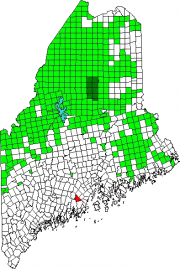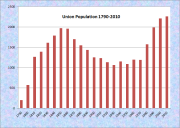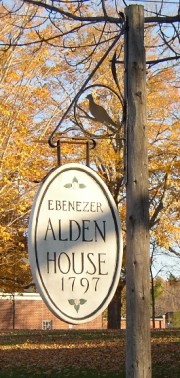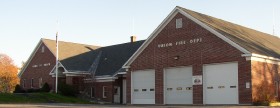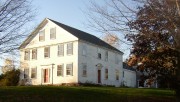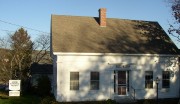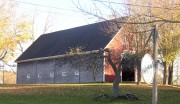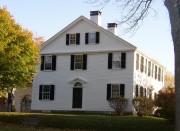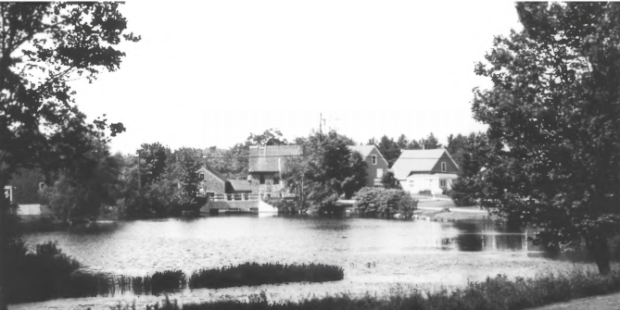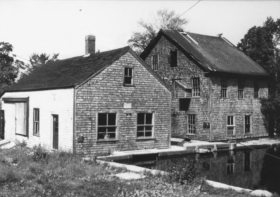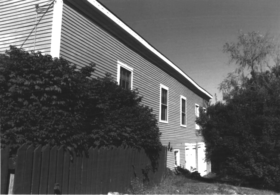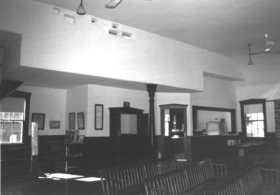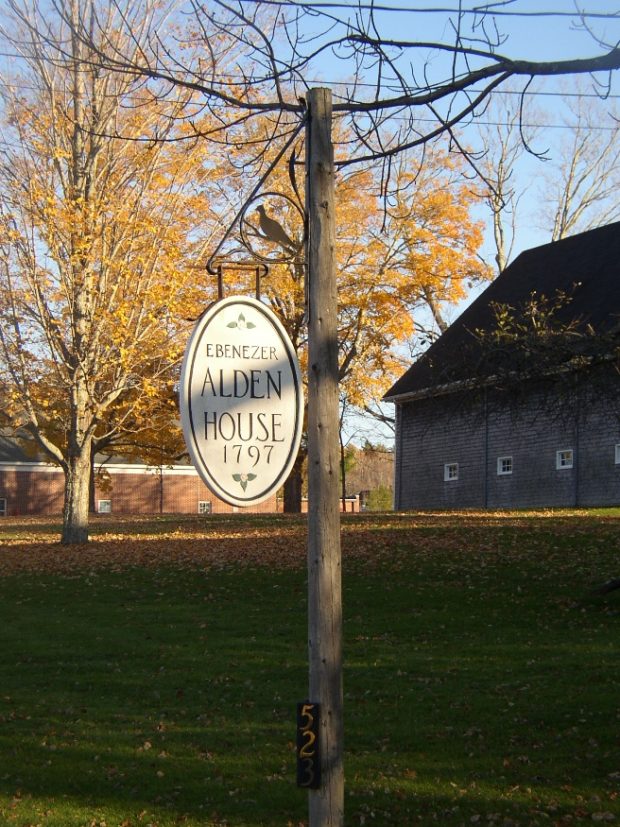
| Year | Population |
|---|---|
| 1970 | 1,189 |
| 1980 | 1,569 |
| 1990 | 1,989 |
| 2000 | 2,209 |
| 2010 | 2,259 |
| Geographic Data | |
|---|---|
| N. Latitude | 44:13:03 |
| W. Longitude | 69:17:30 |
| Maine House | Dist 91,95 |
| Maine Senate | District 12 |
| Congress | District 1 |
| Area sq. mi. | (total) 34.5 |
| Area sq. mi. | (land) 32.4 |
| Population/sq.mi. | (land) 70.4 |
County: Knox
Total=land+water; Land=land only |
|
[YOUN-yun] is a town in Knox County, incorporated on October 20, 1786 from Sterling Plantation. According to the Union Historical Society,
The area was used by Wawenock Native Americans of the Abenaki nation for hunting, fishing, and gathering berries and other vegetables. No permanent settlement existed, but there is evidence of camping and burial sites. They and the white settlers lived together harmoniously but with respectful caution.
In 1772 the first white settlers, natives of Scotland, arrived and called their logging camp “Sterlingtown” after the Scottish town of Stirling.
On April 5, 1790 the town voted to prohibit boars and rams from the Town Common, but permitting hogs to roam at large. In May 1801 the town voted to accept from David Gilmore a donation of the land that forms Union Common [the current location of the Civil War Memorial].
Today Union is primarily an agricultural community, primarily dairy and blueberry farming, a casket factory, a pottery, service-related businesses, and some tourism. Past industries have included quarrying and shipping limestone, growing and shipping apples, and making the barrels to ship them. Small manufacturing included making furniture, carriages, parlor organs, granite monuments and a grist mill.
An 18th century canal system once provided transportation from the town’s Round Pond to Warren.
Union became the subject of Ben Ames Williams’ historical novel Come Spring, which chronicles the early settlement of the town through the lives of the Robbins family, whose home is now that of the Vose Library and the Union Historical Society.
The 1797 Ebenezer Alden House in the main village is on the Register of Historic Places.
Most of the 591-acre Crawford Pond is in South Union (the balance is in Warren) where warm water fishing is reportedly good. The 523-acre Seven Tree Pond is also shared with Warren, with most of its frontage in Union. A boat launch is near Union village. Several smaller ponds also grace the town.
The Knox County Fair is held annually in Union, which is easily reached by Maine Routes 17, 131 and 235. Union village is at the Route 17 and 131/235 intersection in the middle of the town.
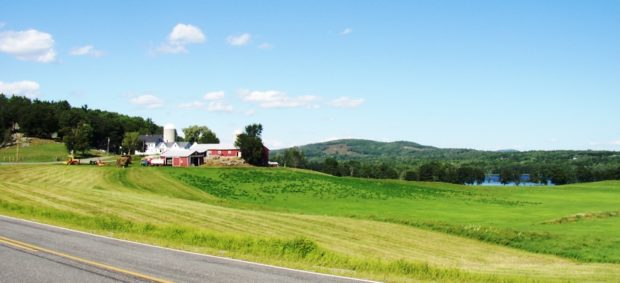
Form of Government: Town Meeting-Select Board-Manager.
Additional resources
Dalton, Pete. Union vs. Dis-union: Contributions of a Small Maine Town in the American Civil War. Union, Me. Union Publishing Co.. c1993. [University of Maine, Raymond H. Fogler Library, Special Collections; Maine State Library]
Maine. Department of Inland Fisheries and Wildlife. “Crawford Pond.” Augusta, Me. 2000. http://www.maine.gov/ifw/fishing/lakesurvey_maps/knox/crawford_pond.pdf; “Seven Tree Pond.” http://www.maine.gov/ifw/fishing/lakesurvey_maps/knox/seven_tree_pond.pdf (accessed April 7, 2014)
*Maine. Historic Preservation Commission. Augusta, Me. Text and photos from National Register of Historic Places: http://pdfhost.focus.nps.gov/docs/nrhp/text/xxxxxxxx.PDF and http://pdfhost.focus.nps.gov/docs/nrhp/photos/xxxxxxxx.PDF
Alden, Ebenezer, House: 75000100.PDF
Common, The: 07001151.PDF
Lermond Mill: 84000499.PDF
Maxcy, Joseph and Hannah, Homestead: 04000743.PDF
Union Town House, Former: 01001419.PDF
Matthews, Edwards A. Horse and Buggy Days: A Brief History of Union, Maine. Belfast, Me. Kelley Press. 1950. [University of Maine, Raymond H. Fogler Library, Special Collections; Bangor Public Library; Maine State Library]
Nash, Chester. 200 Years in Union; a pictorial history of Union, Maine. Rockland, Me. Union Historical Society. 1974. [University of Maine, Raymond H. Fogler Library, Special Collections; Maine State Library]
Sibley, John Langdon, 1804-1885. A History of the Town of Union, in the County of Lincoln, Maine, to the Middle of the Nineteenth Century; . . . . Boston, B. B. Mussey and Co. 1851.
Union Historical Society. “About the Town of Union.” http://unionhistoricalsociety.org/ (accessed December 12, 2014) [source of brief history above, condensed and edited]
National Register of Historic Places – Listings
Alden, Ebenezer, House
[off Maine Route 131] The Ebenezer Alden house is one of the earliest surviving examples of Federal style architecture in Maine. It is a notable example of provincial architecture, relying for decorative example on plan books, in this case William Pain’s Practical House Carpenter published in London in 1794. Its construction date of 1797 makes it a most remarkable and advanced building in a town that was settled barely a generation earlier in 1774 and was still largely wilderness.
Its builder, Ebenezer Alden, was a sixth generation descendant of John and Priscilla Alden of Plymouth Colony. He came to Thomaston in 1792. Here Alden was employed for two years as a wood carver, completing some of the interior decoration over doors, windows, mantels, etc., at Montpelier. That was the summer estate of General Henry Knox, Washington’s Secretary of War. Alden moved to Union in 1795, building himself a small house and shop in 1797 that was Union’s first general store.
This was the first of his dozen or so businesses in the Union area, most notable was his potash works in South Union that produced several tons of lye per year. Alden was Union’s second postmaster, serving in that position for 32 years (1813-45). The house itself is largely a product of Alden’s own hand. On the site he built a brickyard to fabricate bricks for the chimneys and walls. Alden personally carved all the finish detail in wood, with tools he had formerly used at Montpelier.
Alden became a personal friend of General Knox during his employment at the estate and Knox was an occasional visitor to the Alden home. Alden was a bachelor when he built his spacious home. He returned to Massachusetts in 1799, where he married Patience Gilmore of Franklin. The couple returned to Maine and produced twelve children. Alden died in 1862 at the age of 88. The home remained in the family until it was sold in 1965.* [See photos above.]
Common, The
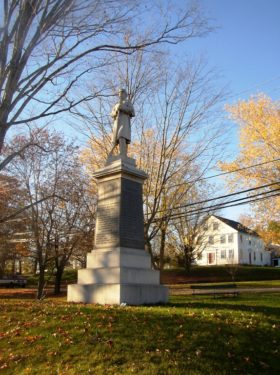 [Between Common & Burkett Roads] The Common in Union is a town-owned green space, a community resource since 1790. Surrounded by 19th and 20th century homes, businesses and civic buildings, the Common was initially set aside by the fledgling community as a shared plot of land on which residents could pasture their livestock, gather, and hold military training.
[Between Common & Burkett Roads] The Common in Union is a town-owned green space, a community resource since 1790. Surrounded by 19th and 20th century homes, businesses and civic buildings, the Common was initially set aside by the fledgling community as a shared plot of land on which residents could pasture their livestock, gather, and hold military training.
Landscape changes occurred throughout the 19th century, first with the removal of ledge and later with the planting of Elm trees. After the Civil War the Common was the site chosen by the local G.A.R. post to erect a stately Civil War monument. 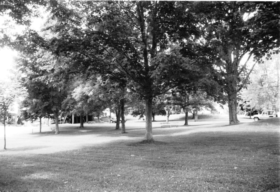 The function of the Common then evolved further into a focal point for entertainment and ceremonies when a bandstand was built in 1895. A monument to World War II veterans continued the tradition of adapting the landscape for public art and commemoration. The Union Common is an example of a designed landscape reflecting early community development, as well as for its 19th and 20th century association with the community’s social history.
The function of the Common then evolved further into a focal point for entertainment and ceremonies when a bandstand was built in 1895. A monument to World War II veterans continued the tradition of adapting the landscape for public art and commemoration. The Union Common is an example of a designed landscape reflecting early community development, as well as for its 19th and 20th century association with the community’s social history.
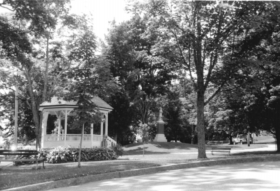
Union was settled between 1772 and 1776 by immigrants from Attleboro, Massachusetts and was incorporated in 1786. As with many other inland towns of the mid-coast region the population grew steadily and strongly through the first decades of the 19th-century. The earliest reference to the Common occurred in 1790; “voted that boars and rams shall not have the liberty of going on the Common,” and later during that April 5 meeting, that “hogs shall have liberty of going on the Common at large.” It is unclear if the boundaries of that space corresponds with the boundaries of the property that was finally deeded to the town in 1809. [Christi A. Mitchell photos (black&white)]
Georges River Canal
[Upper Falls, St. George River in Warren to the Union town line, extending to Quantabacook Pond in Searsmont]
Canals on Georges River, used for access to the forest in its watershed, were important for the development river valley. Mills were built at its lower falls. Charles Barrett of Hope secured a charter from the Massachusetts General Court in 1793 to build locks and bridges creating a canal. More information at Warren.
Lermond Mill
[Union Village] Picturesquely located in a tiny village that appears to be a 19th century time capsule, the Lermond Mill is among the oldest and certainly best preserved of Maine’s still functioning water powered mills. Now serving the dual purpose of grist mill and electrical generation, its history is a microcosm of the milling industry in Maine. Its founder, John Lermond arrived in town in 1795. He built the first dam that created Lermond Pond and built a water-powered pit saw mill. In 1803 he built the earliest of the present structures as a grist mill. An 1825 mill originally housed a woodworking business, making chairs and caskets. A stave works making barrels for coastal shipping was added.
In 1871 a later owner, apparently giving up the woodworking business, operated a clothing works in addition to the still continuing grist mill. In 1897, James Dornan, a stonecutter from Scotland began a granite finishing business in the larger building. By 1928, both structures were devoted to what was referred to as a “monumental works” at which time the covered walkway between the two buildings was built and the mill wheel was replaced by a turbine. In 1972 all milling activity ceased until the mill was purchased in 1978 by Richard Morgan who produced electricity under contract with the Central Maine Power Company, part of which is used to operate an electric powered stone grist mill.* [Frank A. Beard photos, 1984]
Maxcy, Joseph and Hannah, Homestead Maxcy, Joseph and Hannah, Homestead
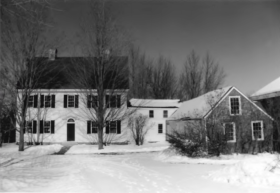 [630 South Union Road] The Homestead of Joseph and Hannah Maxcy is one of a handful of Federal style homes among the interior towns of Mid-Coast Maine, making it a notable example of rural architecture at the turn of the 19th century. It is also significant as a commission by the housewright and joiner Ebenezer Alden (see above). In 1788 Joseph Maxcy came from Attleboro, Massachusetts to Union. The first wave of settlers in the area had arrived fifteen years earlier, but the town had yet to take shape. Initially Joseph cleared land and built a house north of the current village; three years later his brother Josiah and father, Benjamin Maxcy, joined him. The next year Joseph and his brother purchased 45 1/2 acres from their father.
[630 South Union Road] The Homestead of Joseph and Hannah Maxcy is one of a handful of Federal style homes among the interior towns of Mid-Coast Maine, making it a notable example of rural architecture at the turn of the 19th century. It is also significant as a commission by the housewright and joiner Ebenezer Alden (see above). In 1788 Joseph Maxcy came from Attleboro, Massachusetts to Union. The first wave of settlers in the area had arrived fifteen years earlier, but the town had yet to take shape. Initially Joseph cleared land and built a house north of the current village; three years later his brother Josiah and father, Benjamin Maxcy, joined him. The next year Joseph and his brother purchased 45 1/2 acres from their father.
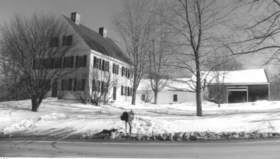
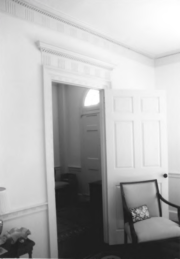 Known as the Mill Farm lot, the parcel included land between Seven Tree Pond and Crawford Pond, and included both sides of Crawford Stream which ran between the two bodies of water. The stream had a strong flow and offered great potential for mill sites. Within a few years the brothers developed the water power, installed a saw and grist mill, and divided the land and mill privileges between themselves.
Known as the Mill Farm lot, the parcel included land between Seven Tree Pond and Crawford Pond, and included both sides of Crawford Stream which ran between the two bodies of water. The stream had a strong flow and offered great potential for mill sites. Within a few years the brothers developed the water power, installed a saw and grist mill, and divided the land and mill privileges between themselves.
Jeremiah Maxcy lived in the Mill Farm, located north of the stream, while Joseph and his wife Hannah built their homestead on a prominent knoll just to the south of where the road to Warren crossed the water. The house was positioned so that it would be prominently visible to travelers heading north or south along the County road, or approaching from the lake to the west.
The growing family had both the means and the time to build a home that would be representative of their increasing prosperity. About 1802 they hired Ebenezer Alden to design and build the new homestead for them.* [Christi A. Mitchell photos, 2004]
Union Town House (Former)
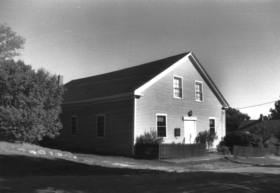 [128 Town House Road] The (Former) Union Town House was built in 1840 as a place to hold town meetings and conduct civic affairs. Over time, the story-and-a-half Greek Revival clapboard-over-frame building has been the location of many of the town’s social and cultural functions. Union was incorporated in 1787, and as with many other inland towns of the mid-coast region the population grew steadily and strongly through the first decades of the 19th-century. In 1839 the Town Meeting voted to build a town-house, to be located near the powder-house; and that it be built according to the blue plan, 40 by 48 feet.
[128 Town House Road] The (Former) Union Town House was built in 1840 as a place to hold town meetings and conduct civic affairs. Over time, the story-and-a-half Greek Revival clapboard-over-frame building has been the location of many of the town’s social and cultural functions. Union was incorporated in 1787, and as with many other inland towns of the mid-coast region the population grew steadily and strongly through the first decades of the 19th-century. In 1839 the Town Meeting voted to build a town-house, to be located near the powder-house; and that it be built according to the blue plan, 40 by 48 feet.
There must have been some disagreement over the use of the structure, for in 1844 the town voted to allow the structure to be used for political uses only, but in 1845 this was overturned and the use left to the discretion of the selectmen. Public worship, justices’ courts and courts of reference, and local band practice were held at the Town House during the 1840’s. The Union Town House is located just up the hill from the town common, which in turn, is surrounded by commercial and religious structures.
The Town House’s location, near the heart of the community parallels the manner in which Union was the hub of agricultural trade and commerce for the surrounding communities during the 19th and early 20th-century. The 1840 census listed 1,784 occupants of Union; the vast majority were involved with agriculture, however thirteen were involved in commerce and ninety-three in manufacturing and trade. Through the 19th century Union’s reputation for good soil spread, and it soon became an important agricultural center. The North Knox Agricultural and Horticultural Society sponsored the first of its fairs in Union in 1869. As people came to Union to conduct business, trade livestock, and visit, they also came to take in the entertainment, the shows, the gatherings and the politics.


